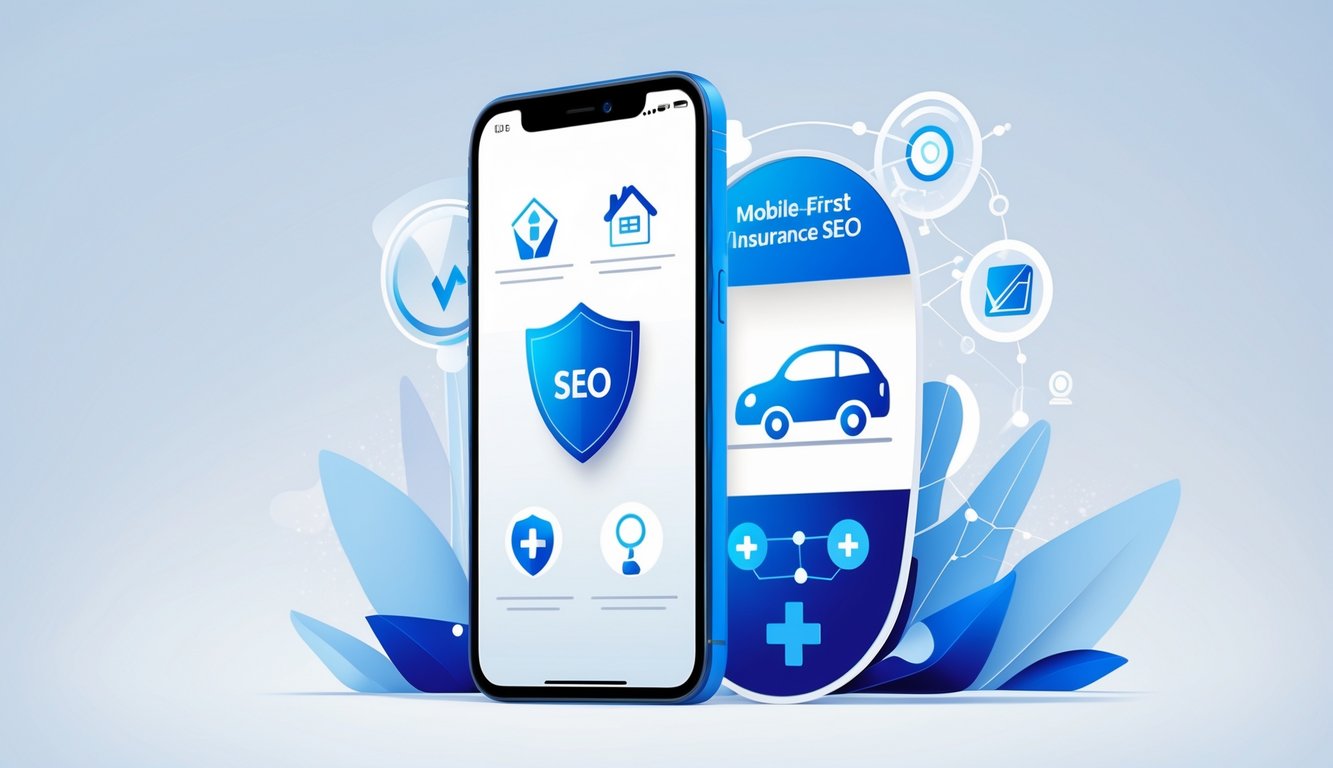Mobile-first insurance SEO is all about making sure your website works best on phones and tablets.
That way, you can reach more folks who search for insurance on their mobile devices.
By focusing on mobile usability and local search, you’ll boost your site’s ranking and draw in people looking for insurance while they’re out and about.

These days, lots of people search for insurance services on their smartphones.
Your content, site speed, and design have to meet mobile standards if you want to stay relevant.
When you put mobile first in your SEO strategy, you make sure you’re not missing out on this huge audience.
It’s one of the best ways to keep up in the insurance world.
If you understand how mobile users search and what they’re after, you can build an SEO plan that actually brings in more qualified traffic.
Paying attention to mobile-first SEO keeps your business in step with both user habits and what search engines want.
Key Takeaways
- Optimizing for mobile gets your insurance site seen and makes it easier to use.
- You need a mobile-friendly design and fast load times for better search rankings.
- When you tailor SEO for mobile users, you attract more local and relevant insurance clients.
Understanding Mobile-First Insurance SEO

Mobile-first insurance SEO means you focus on making your website work great on mobile devices.
You need to know how Google ranks sites and how mobile users affect the insurance industry.
You have to adapt your content, design, and tech features so your site shows up in searches and feels easy to use on phones and tablets.
What Is Mobile-First Insurance SEO
Mobile-first insurance SEO is about designing and optimizing your insurance website mainly for mobile devices.
Most people check insurance quotes on their phones, so your site needs to load fast, look good, and work smoothly on small screens.
Here’s what matters most:
- Responsive design that adjusts to any screen.
- Simple navigation and easy forms.
- Fast load times to keep people from bouncing.
- Clear, straightforward content that’s easy to read on mobile.
When you focus on mobile-first SEO, your site meets Google’s mobile usability standards.
That gives you a better shot at ranking higher when people search for insurance.
Why Google Prioritizes Mobile-First Indexing
Google now ranks websites by looking at their mobile version first, not the desktop one.
So, Google checks how your site works on phones and tablets before deciding where you show up in search results.
This helps Google:
- Give mobile users more useful results.
- Make sure sites offer a good experience on mobile.
- Push pages that are quick and easy to use.
If your mobile site drags or feels clunky, Google drops you down in the rankings.
Focusing on mobile performance really does affect how many people find you.
Impact on the Insurance Industry
Mobile-first SEO really matters for insurance companies because most customers now research and buy insurance on their phones.
If your site isn’t mobile-friendly, you’ll probably lose leads to competitors who offer a better mobile experience.
Mobile optimization in insurance means a few things:
- Make quote forms quick and simple.
- Show clear policy info without endless zooming or scrolling.
- Use local SEO to catch people searching nearby on mobile.
When you use mobile-first SEO, you connect with customers where they already are.
That gives you a better shot at conversions and helps build trust in your brand.
You can get more tips about mobile web design from Lollypop Design Studio’s projects.
Building an Effective Mobile-First SEO Strategy for Insurance

To do mobile-first SEO right, you need to focus on site speed, clear navigation, content that’s easy to read on small screens, and a solid technical setup.
These pieces work together to help your site rank better and bring in more mobile clients.
Optimizing Site Speed and Performance on Mobile
Your insurance website has to load fast on mobile devices.
If it’s slow, people leave and your rankings drop.
Compress your images but keep them looking sharp.
Go with formats like WebP to help with this.
Cut back on heavy scripts and unnecessary plugins.
Use browser caching and a Content Delivery Network (CDN) so your content loads faster, no matter where users are.
Check your mobile site speed with Google PageSpeed Insights.
Follow the advice you get to boost your site’s performance.
Designing for User Experience and Accessibility
People want a simple, smooth user experience on mobile, especially when they’re shopping for insurance.
Make sure your navigation is clear, buttons stand out, and text is easy to read.
Go with a responsive design that works on every screen size.
Skip pop-ups that block content—they just annoy users on small screens.
Don’t forget accessibility.
Your site should work with screen readers, have enough color contrast, and include alt text for all images.
You want people to find quotes, contact info, and policy details without any hassle.
Mobile Content Optimization Techniques
Keep your content short and easy to scan on small screens.
Use short paragraphs, bullet points, and clear headings to break up the text.
Stick to relevant insurance topics.
Use keywords naturally so your site pops up in mobile searches.
Add structured data to help search engines understand your services.
This can make your mobile search listing stand out.
Make your CTAs (calls to action) big enough to tap and clear about what users should do next, like getting a quote or talking to an agent.
Mobile Technical SEO Best Practices
Mobile technical SEO helps search engines crawl and index your site right on mobile.
Use the same HTML for both desktop and mobile pages.
Don’t let content get out of sync between versions.
Double-check that your mobile site uses a friendly URL structure.
Avoid bad redirects that trip up users or search engines.
If you serve different languages or regions, set up hreflang tags.
Use canonical tags the right way so you don’t get hit with duplicate content problems.
Audit your mobile site with Google Search Console to catch errors and keep an eye on indexing.
If you want to go further, work with insurance marketing companies that know mobile-first strategies.
They can help you get more leads and boost your online presence.
You can find more info in this insurance marketing companies guide.
Frequently Asked Questions

Your insurance website needs to work well on phones and tablets if you want to stay visible online.
Fast loading times, clear navigation, and mobile-friendly design all help your site rank higher and make things easier for users.
How does mobile-first indexing impact insurance companies’ online visibility?
With mobile-first indexing, Google checks your mobile site first.
If your mobile site is slow or clunky, you’ll drop in visibility.
You need to make sure your content and pages look good and work right on mobile.
What are the best practices for optimizing insurance websites for mobile users?
Use simple fonts and big buttons.
Don’t clutter your pages, and make forms easy to fill out on small screens.
Test your site on different devices to make sure it always works well.
Can mobile responsiveness affect my insurance site’s search engine rankings?
Absolutely.
Mobile responsiveness is a big ranking factor.
Sites that fit any screen easily will always rank better than ones that are tough to use on mobile.
What role does page loading speed play in mobile SEO for insurance providers?
Page speed really matters for both rankings and keeping visitors happy.
Faster pages mean fewer people leave.
Compress your images and trim your code to help your site load faster.
How should insurance businesses structure their mobile websites for better SEO results?
Break up your content with clear headings and short paragraphs.
Make sure phone numbers and location buttons are clickable.
Keep navigation simple so people can find what they need quickly.
What are the key elements of a mobile-optimized site for the insurance industry?
You want your site to load quickly.
People should find it easy to get around, with text that’s actually readable.
Keep your forms simple.
Make sure you use responsive design, and always add calls to action that work well on phones.
If you’re curious about building a site for your business, check out how simple it can be with modern tools and templates at Forbes advisor.
Want to keep up with SEO trends, especially around AI content and user experience? Take a look at Business Connect India.






